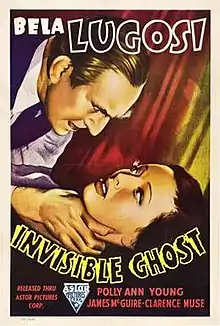Invisible Ghost
Invisible Ghost is a 1941 American horror film starring Bela Lugosi and directed by Joseph H. Lewis. It was the first of the nine movies interpreted by Bela Lugosi for Sam Katzman at Monogram Pictures.[1]
| Invisible Ghost | |
|---|---|
 A promotional film poster for "Invisible Ghost." | |
| Directed by | Joseph H. Lewis |
| Produced by | Sam Katzman |
| Written by | Al Martin Helen Martin |
| Story by | Helen Martin Al Martin |
| Starring | Bela Lugosi Polly Ann Young John McGuire |
| Music by | Johnny Lange Lew Porter |
| Cinematography | Harvey Gould Marcel Le Picard |
| Edited by | Robert Golden |
Production company | Monogram Pictures Banner Pictures Corporation |
| Distributed by | Astor Pictures Corporation |
Release date |
|
Running time | 64 min |
| Country | United States |
Plot
The home of Charles Kessler (Bela Lugosi) is beset by a series of unsolved murders. Kessler, who lives with his daughter and servants since his wife left him, is shown to be the murderer, unbeknownst to himself. His wife (Betty Compson), who became brain-damaged in a car accident not long after leaving him, has been visiting the grounds of the house and the sight of her through his window puts Kessler into a trance-like state which makes him homicidal. Ralph Dickson, the fiancée of Kessler's daughter, is convicted and executed for one of the murders. His twin brother Paul arrives and, through a series of events, including Kessler's wife finally entering the house and being seen by others, Kessler is seen to go into the trance and the mystery is revealed.
Cast
_1.jpg.webp)
- Bela Lugosi – Dr. Charles Kessler
- Polly Ann Young – Virginia Kessler
- John McGuire – Ralph Dickson and Paul Dickson
- Clarence Muse – Evans the Butler
- Terry Walker – Cecile Mannix
- Betty Compson – Mrs. Kessler
- Ernie Adams – Jules Mason
- George Pembroke – Police Lieutenant Williams
- Ottola Nesmith – Mrs. Mason (as Ollola Nesmith)
- Fred Kelsey – Detective Ryan
- Jack Mulhall – Detective Tim
Production
It was originally known as Murder by the Stars then The Phantom Monster.[2] During filming it was called The Phantom Killer.[3]
Filming took place from 20 March to April 1941.[4] As soon as the film was completed it was announced Lugosi and Katzman would make two more films together;[4] they eventually wound up making nine in all.
Reception
The Los Angeles Times said the film was "head and shoulders above the average horror picture. It's superiority is based on the fact that spine-tickling qualities stem from a psychopathic and psychological situation rather than a purely physical one, imparting a Poe-ish flavour... Lugosi is, of course, superb in his work, being master of all the horror tricks but never overdoing them".[5] Author and film critic Leonard Maltin awarded the film two out of a possible four stars, calling it "Better written and directed than most of Bela's 1940s cheapies, but still a far-cry from Dracula".[6]
References
- Gary D. Rhodes, "A House Where Anything Can Happen and Usually Does", The Films of Joseph H Lewis p 81-97
- "Of Local Origin". New York Times. Mar 14, 1941. p. 17.
- "Lugosi-Katzman". Los Angeles Times. May 2, 1941. p. 29.
- Tom Weaver, Poverty Row Horrors! Mongram, PRC and Republic Horror Films of the Forties, 1993 p 26-35
- G. K. (Apr 12, 1941). "Lugosi Opus Real Thriller". Los Angeles Times. p. A9.
- Leonard Maltin (2015). Classic Movie Guide: From the Silent Era Through 1965. Penguin Publishing Group. p. 331. ISBN 978-0-14-751682-4.
External links
| Wikiquote has quotations related to: Invisible Ghost |
- Invisible Ghost at IMDb
- Invisible Ghost is available for free download at the Internet Archive
- Invisible Ghost at AllMovie
- Joe Dante on Invisible Ghost at Trailers from Hell